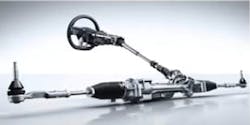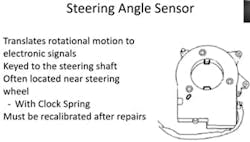Today's, let's talk about vehicle steering systems. In our industry there are five types of systems:
- Worm and sector: One of the first widely used steering systems, utilizing a worm gear that meshes with a sector gear to turn the wheels. Late 1800s – early 1900s. Ford Model T and Model A used it.
- Recirculating ball: Featuring a worm gear rotating ball bearings within a housing to reduce friction and provide smoother steering. Started with the 1940 Cadillac and is still used today, but with hydraulic assist.
- Rack and pinion: A compact, efficient, and simple system that uses a shaft, pinion, rack, and tie rod to translate rotation into linear motion. It's often used in small cars. The BMW 303 was the first rack and pinion in the 1930s. The first U.S.-built car was the Ford 1974 Mustang ll and the Pinto.
- Hydraulic power steering: A compact system that uses a hydraulic power assist unit to help the driver turn the steering wheel. It's known for its superior steering performance. The concept of assisted steering dates back to the late 1890s. The first commercially available power steering was the 1951 Chrysler Imperial.
- Electric power steering (EPS): A modern system that uses an electric motor and sensors to assist the driver in turning the steering wheel. It's popular for its fuel efficiency and flexibility.
The evolution of steering systems primarily saw the development of mechanical systems like worm and sector and recirculating ball, followed by the introduction of power steering, with hydraulic systems being the first widely adopted, later transitioning to electric power steering as technology advanced. The most common modern system today is the rack and pinion steering, often combined with electric power assistance.
In this article, we discuss the electric power assist component. Original equipment manufacturers (OEM) are moving aggressively to EPS because eliminating an engine-driven hydraulic pump increases gas mileage by about one mile per gallon (mpg).
Advancements in electronics led to the development of EPS, which is now widely adopted in modern vehicles due to its efficiency and adaptability.
The history of electric power steering dates to the late 19th century, with early patents for electrically assisted steering systems existing even before the first automobiles. It gained widespread adoption in recent decades with the 1990 Honda® NSX® being one of the first production cars to feature a fully electric power steering system. The key development being the ability to integrate sensors and adjust steering assistance based on vehicle speed and other factors, making it more efficient and driver-friendly than older hydraulic systems.
In most vehicles, the electric power steering motor is located within the steering column, meaning the EPS is considered part of the steering column assembly. This design is often referred to as column-assist EPS where the motor is mounted directly on the steering column itself.
Key points about EPS in the steering column:
- Function: The electric motor within the steering column assists the driver by providing power to turn the wheels, making steering easier, especially at low speeds.
- Sensors: Sensors in the steering column detect the driver's steering input and torque, allowing the EPS system to adjust the amount of assistance needed.
- Space-saving: Placing the EPS motor in the steering column is a common space-saving design choice for smaller vehicles.
While doing research on electric power steering, I found a complimentary SureTrack blog. This entry talks about some very interesting points.
So, with what we have been talking about, it may come down to replacing the entire steering column to properly repair these car steering systems. Take a look:
Suretrackblog.com
Vehicle
2006 Saturn Ion 2 2.2L — same as Vauxhall.
Title
Code C0475, power steering inoperative, replaced the steering column.
Complaint
The customer states the power steering is inoperative. The customer also states the anti-lock brake system (ABS) light is on.
Cause
Confirmed the customer’s complaint and found the power steering was inoperative. Connected a scan tool and found code C0475 – electric steering motor circuit. With the engine at idle, monitored live scan tool data while attempting to turn the steering wheel from left to right and found the electric steering motor parameter was fixed. Performed an inspection of the electric steering motor wiring harness and connector and detected no obvious faults. With the ignition on and the engine off, used a multi-meter to check for the presence of voltage and ground at the electric steering motor connector and found both were present, indicating the electric steering motor was faulty. The electric steering motor is integrated into the steering column and is replaced as an entire unit.
Correction
Replaced the steering column and verified the vehicle operated properly. The customer's concern did not return.
The typical electric steering assembly would consist of steering angle sensors, the torque effort sensor, the electric motor and the electric steering rack. Some refer to this as an electronic power system. I certainly wouldn’t argue that.
What happens if the steering angle sensor is not calibrated with a scan tool? If the sensor is not calibrated properly, the ADAS might misinterpret steering inputs, leading to false warnings or inappropriate vehicle responses. If not calibrated, it would certainly be a comeback.
What are the signs of a faulty sensor?
- Warning lights: The most noticeable sign is usually the electronic stability (ESC) or traction control light illuminating on the dashboard.
- Steering feel: You might experience a loose or "playful" steering wheel, meaning there is noticeable movement before the car starts to turn.
- Inconsistent handling: The car might feel unstable or pull to one side during turns, especially after a wheel alignment.
- Loss of stability control functions: Features like traction control and stability control might not work properly due to inaccurate steering angle data
- Squealing tires: In some cases, a faulty sensor can lead to excessive tire wear and squealing noises when cornering.
In the late 70s, I worked in an alignment shop. The alignment machine I used had a tape measure and string. My main steering repair tools were a couple of wrenches, a hammer, a pipe wrench, and a pickle fork. I would not have dreamed that we would be required to hook a scan tool up after performing an alignment to calibrate, reset, or relearn various electronic components today.
About the Author

Keith Wray
With over 45 years of experience in the automotive industry, Keith Wray started his career as a technician/automotive machinist and worked his way up to a service manager for an OEM dealership. He currently serves as the national training manager for Snap-on Diagnostics where he co-develops training materials as well as conducts technical courses for franchisees, employees, end-users, and vocational students.


